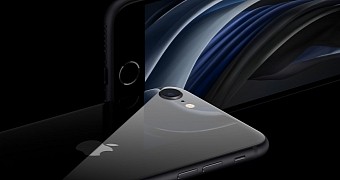Apple launched the 2020 iPhone SE with a familiar design and feature lineup, including a home button with integrated Touch ID.
The return of the fingerprint sensor comes at a time when Apple is all about Face ID, the facial recognition system that’s offered on new-generation iPhones and the preferred biometric system for the Cupertino-based tech giant moving forward.
Many consider the Touch ID comeback living proof of Apple going in the wrong direction with Face ID, while others believe it’s more of a mea culpa that the company makes after removing the feature in the first place.
In fact, Touch ID on the iPhone SE is actually something that totally makes sense, and it’s all because Apple could very well adopt a completely new approach that would perfectly align with its strategy of offering more affordable iPhones alongside its premium devices.
First and foremost, it’s important to have a look at how the iPhone SE is positioned right now. As Apple’s most affordable iPhone, the new model comes with Touch ID not only because it’s the feature that came bundled with the iPhone 8, the device whose design the iPhone SE borrows, but also because it’s cheaper than Face ID.
In other words, Apple uses Touch ID because it can thus keep the price at a lower level, as the addition of facial recognition would only make the device overall more expensive.
Now rumor has it that Apple would also bring Touch ID to a cheaper iPad coming next year. Again, the key word here is “cheaper,” so Touch ID would one more time be used on a device whose purpose isn’t to sell for a premium, but to actually be offered as an alternative to the more expensive sibling.
At first glance, Apple wants to use Touch ID and Face ID as two features that would help make a bigger difference between cheaper and more expensive models.
This means the more affordable devices, like the 2020 iPhone SE (and possibly its successors) and the upcoming iPad due in 2021, would feature Touch ID, whereas the more expensive models, like the 2020 iPhones with 5G, would stick with Face ID for a top-of-the-line experience.
This means Apple would embrace a completely different strategy as compared to its rivals. Huawei, for example, wanted to offer everything on just one device, so it bundles both fingerprint scanners and facial recognition with its high-end models. Apple, on the other hand, would actually offer them separately, so customer who’d want to upgrade from Touch ID to Face ID would have to pay extra for a premium iPhone.
This doesn’t necessarily mean Touch ID itself wouldn’t evolve even more beyond the current implementation. Rumor has it that Apple wants to put the fingerprint sensor under the screen, pretty much like Samsung currently offers on the latest-generation Galaxy S. So sooner or later, there’s a chance the home button itself would go away, but instead, the fingerprint sensor would stick around for many years.
Of course, it’s too early to tell when this could happen, but Touch ID could be upgraded with a version under the screen next year when this mysterious iPad will go live. This is just a rumor for now, so a certain amount of skepticism is certainly recommended.
For now, however, all of these make sense for Apple in the long term, especially as the company wants the iPhone to be aimed at a wider audience. And now that the 2020 iPhone SE is here, Apple’s long-term strategy can finally advance at full speed.

 14 DAY TRIAL //
14 DAY TRIAL //